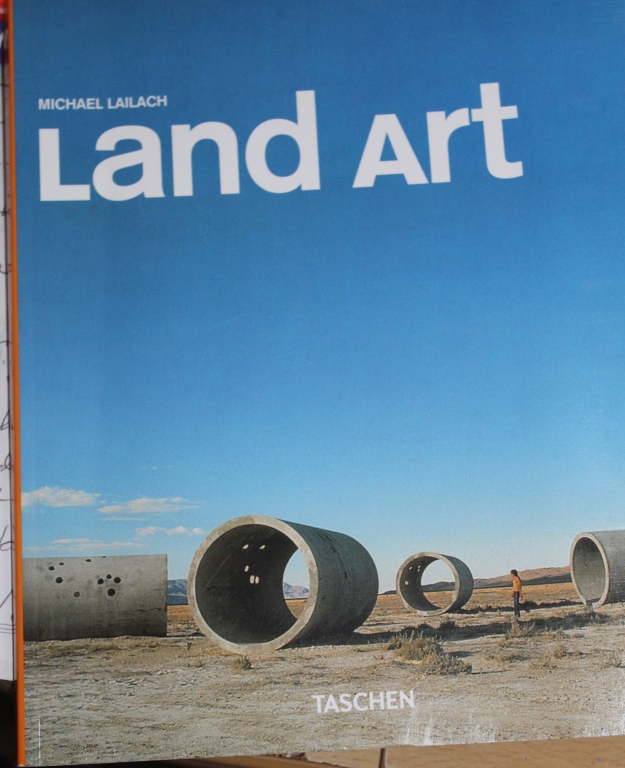SEMIOTICS
Sign = Signifier + Signified
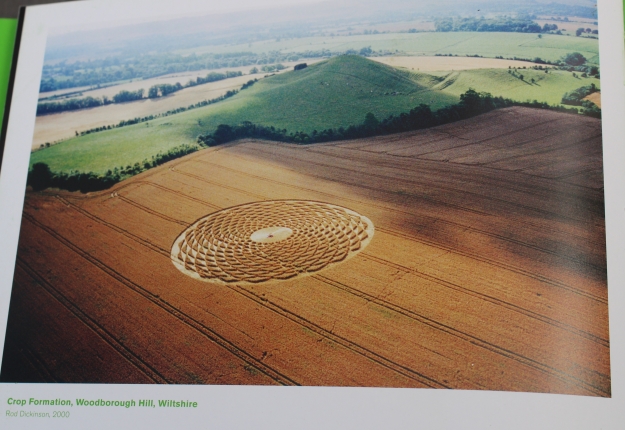
Place : Dean and Miller Thames and Hudson 2005
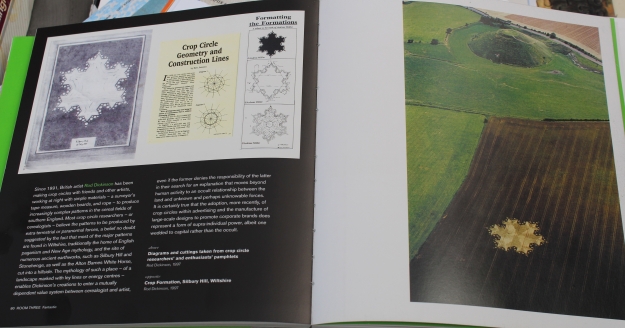
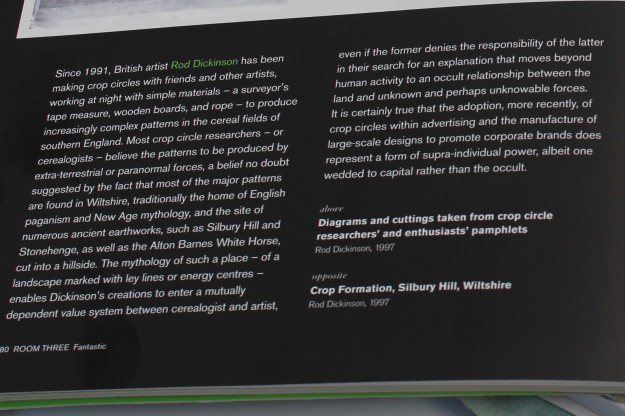
Wikipedia – (used as a starting point for information/leads etc)
A crop circle or crop formation is a pattern created by flattening a crop,[1] usually a cereal. The term was first coined in the early 1980s by Colin Andrews.[2] Crop circles have been described as all falling “within the range of the sort of thing done in hoaxes” by Taner Edis, professor of physics at Truman State University.[3] Although obscure natural causes or alien origins of crop circles are suggested by fringe theorists,[4] there is no scientific evidence for such explanations, and all crop circles are consistent with human causation.[5][6][7]Formations are usually created overnight,[10] although some are reported to have appeared during the day.[11] In contrast to crop circles or crop formations, archaeological remains can cause cropmarks in the fields in the shapes of circles and squares, but they do not appear overnight, and they are always in the same places every year.They have also been found near mounds of earth and stones raised over a grave or graves, also known as tumuli barrows, or barrows and chalk horses, or trenches dug and filled with rubble made from brighter material than the natural bedrock, often chalk.
Researchers of crop circles have linked modern crop circles to old folkloric tales to support the claim that they are not artificially produced.[12] Circle crops are culture-dependent: they appear mostly in developed and secularized Western countries where people are receptive to New Age beliefs, including Japan, but they don’t appear at all in other zones, such as Muslim countries.[72]
Crop circles, more than anything else, are land art pieces.
Crop circles: the infamous and strange formations created on crop fields, where wheat or maize is taken to a new level of existence. All around the world, these mysterious formations make their debut. England, however, is where the phenomenon has its major platform. Some even call the county Wiltshire in south England the Mecca of crop circles. Usually they appear in fields which are close to ancient monuments like Stonehenge. Allegedly, there are reports of crop circles dating back to 1678, but no one really knows when these formations started to appear. What is certain is that they developed into a worldwide phenomenon in the 1970s.
Immediately one is prompted to ask who made these things and what they really are. Are they simply hoaxes? Messages from extraterrestrials? A network of Earth’s energy “spots” that rests on sacred geometry?
Many do believe that these formations are alien-made or that they represent messages from the Earth itself. The new age movements are particularly keen on this idea. The complexity and size of the formations as well as the heavy symbolic nature they display play the fundamental role in such interpretations. However, there are others who criticize these beliefs, claiming it is precisely because of this that the formations are created – to propagate new age ideologies. Even if not intended for such a goal, they are man-made and do not involve any kind of other-worldly beings. The argument is that like every other type of artwork: there is an “ego” behind the complexity of the works which rejoices in the accomplishment. They may stay behind the scenes but the ego is clearly a sign that no extraterrestrial activity is involved.
The debate between believers and non-believers hardened when in 1991, Doug Bower and Dave Chorley reported they were responsible for the crop circles. Despite such a claim many were not convinced of this. Most of its shrouding mystery is related to aspects which are very difficult to explain. The “hoaxers” tried to exemplify how a circle could be made using only a rope and a plank of wood. But in the formations, crop stalks appear not to be broken, but merely flattened, bent at 90 degree angles. Moreover, scientific evidence has also shown that the cellular structure and the soil chemistry are both changed by the formations. This has caught the attention of some scientists who have tried to understand how the crop circles are done. Richard Taylor, director of the Materials Science Institute at the University of Oregon affirmed that it is most probable that crop circle makers use GPS, lasers and microwaves. Indeed, several analyses showed that the stalks seemed to be microwaved and a mere plank of wood does not seem capable of producing such results.
Yet it is precisely this fierce debate that has made crop circles widely known about. Interestingly, in the case of crop circles, the hoaxes are not hoodwinking us by presenting a fake as something genuine. The hoaxes are actually copying something which we don’t know the origins of. How do we define the “real thing”? This is a term used by the other-worldly theorists to criticize hoaxers. The relationship between believers and hoaxers is actually a symbiotic one. For those who create the formations, there’s nothing better than a flair of mystery to advertise their work. Likewise, those who believe in some sort of other-worldly influence also need the so-called “man-made” circles. This is a way to support the claim that some of the crop circles were made with technology that the hoaxers do not possess, thus distinguishing the “man-made” from the unexplained.
Of course, beyond believers and non-believers, there is one group which seems satisfied with the phenomenon, regardless of who or what is really responsible: farmers. The pieces attract tourists, specifically new age tourists. Helicopter tours, t-shirts, donations or small fees infuse money into the county’s economy. This is certainly more than a normal crop would provide for farmers and the local community. Everyone seems to profit.
But let us absolve ourselves from the “who is who”, the “who did and who didn’t” conundrum.
Let us take the formations for what they really are. Above all, these formations are land art pieces and magnificent ones at that. Their framework is the human imaginarium par excellence; the representation of the relationship between man and the unknown. The scale, the mystery and, more importantly, the scientific discourse involved has a magical aura.
Like land art, not only is the museum left behind but there is a ritual involved. The “journey” is an extremely significant part of this ritual. Most land art pieces lie in the middle of deserts, vast areas which are difficult to access. Although south England may not be the same as a desert in Utah, people nevertheless travel miles and miles just to visit a corn field. The reason for doing this, as with the majority of land art pieces, is to fulfill an expectation. You need to see it with your own eyes. Entangled in a game of mystery and awe, science becomes enchanting and art a mathematical piece of evidence of the unexplainable.
The riddle and even the expectation of an epiphany all catalyze the spirit. It is the puzzling nature of the circles that creates such feeling of the sublime. It is the experience of the elusive in itself and the ineffable as itself which lies at the center of this kind of art. The “aura”, to use a Benjamin concept, of the crop circles awakens an ancient relationship between the beholder and its environment. The world appears in all its magnitude, as the cosmos, as opposed to the mere visual immediacy with no riddle that we are used to, with nothing to reach beyond.
There is no need for any Occam’s razor here. The makers of the circles, whoever or whatever they are, are artists. Geometry is their pencil, the “what if” their ideology, while the earth provides the canvas.
https://www.fairobserver.com/culture/crop-circles-elusive-land-art/
Rod Dickenson makes crop circles on the ancient lands of England, the West Country. For me the West Country is magic… ancient land which hold memories of old. The crop circles in Whiltshire, Stone Henge, and Avery are all perfect in line, where lay lines are hidden. Sidbury Hill, 2400 BC, is the largest man-made hill. Iron age settlers built these ancient earthworks for their pagan gods. They are all based on complex geometry, which is obvious from above, normally in the form of a circle, but also square, or horseshoe-shaped
David Keys writes in the Independent that “It shows the builders of Stonehenge had a sophisticated yet empirically derived knowledge of Pythagorean geometry 2000 years before Pythagoras.” and that The most complex geometrical achievement at Stonehenge is an 87-metre diameter circle of chalk-cut pits which mark the points of a 56-sided polygon, created immediately within the monument’s perimeter earthwork.
Rob Dickinson’s construction of crop circles are simplistic versions, with only six points. With the help of sacred geometry, you can construct one with simple materials such as surveyors tape, wooden boards and rope. They are complex patterns which are impressive from above, but use a simple formula precisely executed.
The significance of Dickinson’s work is in the location, where he places his crop circles. They are all in proximity to an English Heritage site. Crop circles use the same Pythagorean principles as the Stone circles and sites, and symbolizes a mystery that has been perhaps forgotten about.
David Keys, The Independent,http://www.independent.co.uk/news/uk/home-news/stonehenge-builders-had-geometry-skills-to-rival-pythagoras-834313.html [17-5-17]
Since then, crop circles have been reported worldwide in a multitude of crops. In southern England, which sees most activity, circle-makers tend to concentrate on canola, barley and wheat. These grow and are harvested in an overlapping progression: canola from April through May, barley throughout May and June, and wheat from June until early September. In recent years the occasional rudimentary pattern has been found in corn, extending the crop circle season as late as October. Since Bower and Chorley’s circles appeared, the geometric designs have escalated in scale and complexity, as each year teams of anonymous circle-makers lay honey traps for New Age tourists.
A crucial clue to the circles’ allure lies in their geographical context. Wiltshire is the home of Stonehenge and an even more extensive stone circle in the village of Avebury. The rolling downs are dotted with burial mounds and solitary standing stones, which many believe to be connected by an extensive network of “leys,” or paths of energy linking these enchanted sites with others around the country. It is said that this vast network is overlaid in the form of “sacred geometries.” The region has also given rise to a rich folklore of spectral black dogs, headless coachmen and haunted houses.
Crop circles are a lens through which we can explore the nature and appeal of hoaxes. Fakes, counterfeits and forgeries are all around us in the everyday world—from dud $50 bills to spurious Picassos. People’s motives for taking the unreal as real are easily discerned: we trust our currency, and many people would like to own a Picasso. The nebulous world of the anomalous and the paranormal is even richer soil for hoaxers. A large proportion of the population believes in ghosts, angels, UFOs and ET visitations, fairies, psychokinesis and other strange phenomena. These beliefs elude scientific examination and proof. And it’s just such proof that the hoaxer brings to the table for those hungry for evidence that their beliefs are not deluded.
False evidence intended to corroborate an existing legend is known to folklorists as “ostension.” This process also inevitably extends the legend. For, even if the evidence is eventually exposed as false, it will have affected people’s perceptions of the phenomenon it was intended to represent. Faked photographs of UFOs, Loch Ness monsters and ghosts generally fall under the heading of ostension. Another example is the series of photographs of fairies taken by Elsie Wright and Frances Griffiths at Cottingley, Yorkshire, between 1917 and 1920. These show that the motive for producing such evidence may come from belief, rather than from any wish to mislead or play pranks. One of the girls insisted till her dying day that she really had seen fairies—the manufactured pictures were a memento of her real experience. And the photos were taken as genuine by such luminaries as Sir Arthur Conan Doyle—the great exponent, in his Sherlock Holmes stories, of logic.
The desire to promote evidence of anomalous and paranormal events as genuine springs from deep human longings. One is a gesture toward rationalism—the notion that nothing is quite real unless it’s endorsed by reasoned argument, and underwritten by more or less scientific proofs. But the human soul longs for enchantment. Those who don’t find their instinctive sense of the numinous satisfied by art, literature or music—let alone the discoveries of science itself—may well turn to the paranormal to gratify an intuition that mystery dwells at the heart of existence. Such people are perfectly placed to accept hoaxed evidence of unexplained powers and entities as real.
And so, the annual appearance of ever more complex patterns in the wheat fields of southern England is taken by “croppies”—the devotees who look beyond any prosaic solution for deeper explanations—as signs and wonders and prophecies. The croppies do, however, accept that some people, some of the time, are making some of the formations. They regard these human circle-makers as a nuisance, contaminators of the “evidence,” and denounce them as “hoaxers.” The term is well chosen, for it implies social deviance. And therein lies the twist in the story.
In croppy culture, common parlance is turned on its head. The word “genuine” usually implies that something has a single, identifiable origin, of established provenance. To the croppy it means the opposite: a “genuine” circle is of unknown provenance, or not man-made—a mystery, in other words. It follows that the man-made circle is a “hoax.”
Those circle-makers who are prepared to comment on this semantic reversal do so with some amusement. As far as they’re concerned, they are creating art in the fields. In keeping with New Age thought, it is by dissociating with scientific tradition that the circle-makers return art to a more unified function, where images and objects are imbued with special powers.
This art is intended to be a provocative, collective and ritual enterprise. And as such, it is often inherently ambiguous and open to interpretation. To the circle-maker, the greater the range of interpretations inspired in the audience the better. Both makers and interpreters have an interest in the circles being perceived as magical, and this entails their tacit agreement to avoid questions of authorship. This is essentially why croppies regard “man-made” circles as a distraction, a “contamination.”
Paradoxically, and unlike almost all other modern forms of art, a crop circle’s potential to enchant is animated and energized by the anonymity of its author(s). Doug Bower now tells friends that he wishes he had kept quiet and continued his nocturnal jaunts in secret. Both circle-makers and croppies are really engaged in a kind of game, whose whole purpose is to keep the game going, to prolong the mystery. After all, who would travel thousands of miles and trek through a muddy field to see flattened wheat if it were not imbued with otherworldly mystique?
As things stand, the relationship between the circle-makers and those who interpret their work has become a curious symbiosis of art and artifice, deception and belief. All of which raises the question: Who’s hoaxing whom?
Read more: https://www.smithsonianmag.com/arts-culture/crop-circles-the-art-of-the-hoax-2524283/#pBIDZRuWig0YvLOe.99
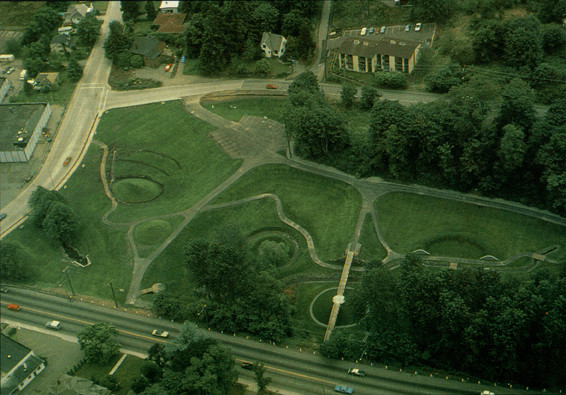

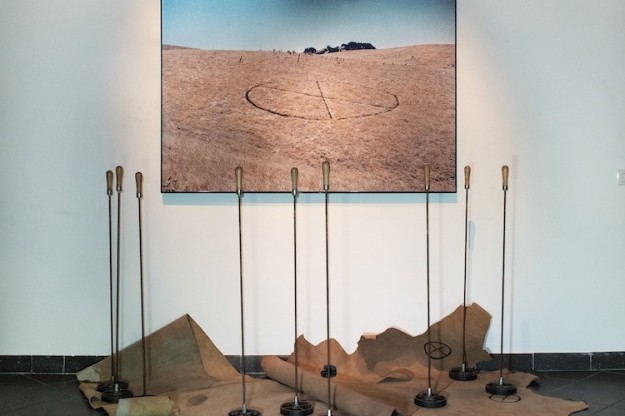
“The work is not put in the place, it is the place”
Dennis Oppenheim
https://artmap.com/mgksiegen/exhibition/robert-smithson-2012
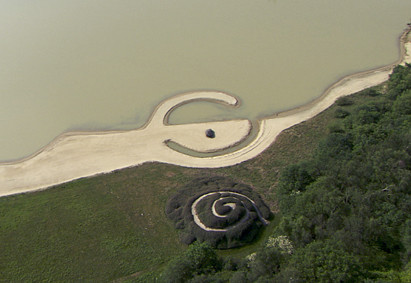
ROBERT SMITHSON
The Invention of Landscape. Broken Circle/Spiral Hill & Film
4 March – 28 May, 2012
CROP CIRCLES
Circle means
- Round
- Womb
- Focus
- Unity
- Cycles
- Infinity
- Mobility
- Inclusion
- Wholeness
- Nurturing
- Initiation
- Everything
- Perfection
- Centering
- Revolution
- Completion
-
a universal symbol with extensive meaning. It represents the notions of totality, wholeness, original perfection, the Self, the infinite, eternity, timelessness, all cyclic movement, God (‘God is a circle whose centre is everywhere and whose circumference is nowhere’ (Hermes Trismegistus)
Crop means
- Plant
- batch, lot, assortment, selection, collection, supply, intake
- harvest, reap, mow; gather, collect, pick,
- Cut
Crop circle means
- a geometric and especially a circular pattern of flattened stalks in a field of grain now usually attributed to natural phenomena or to the work of hoaxers trying to create the impression of a visit by extraterrestrial beings
- Legend
- Myth
- Aliens
- Flattened crops
- Geometric shapes
- Hoax
- Mystery
- archeology
As Sean Hall says (This means This This means That, Laurence King 2012) ‘ It is the connection in our minds … which makes … successful in terms of communication.’








